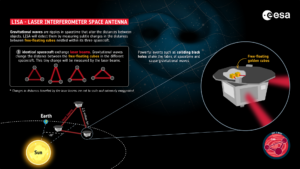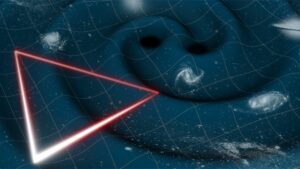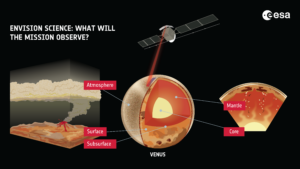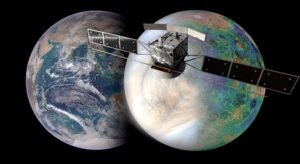Gravitational wave observatory LISA and Venus mission EnVision approved
European Space Agency´s (ESA) Science Programme Committee on its meeting on 25 January 2024 adopted large gravitational wave observatory LISA and mission to Venus, EnVision. Czech scientists will participate in both missions, which will be funded from the ESA´s Science Programme and the contribution of the Ministry of Education, Youth and Sports in it.
The LISA mission
LISA (Laser Interferometer Space Antenna) is the second large “flagship” mission of the European Space Agency’s (ESA) Science Programme. The LISA mission will be the first dedicated space-based gravitational wave observatory. LISA is to be launched in 2035.
LISA mission, credit: ESA
The mission will consist of three spacecraft transmitting a laser beam at a distance of up to 2.5 million kilometres. Each of the three spacecraft will carry two redundant laser beam sources. As the gravitational wave passes, the phases of the laser beams change, which makes it possible to capture ancient and very distant collisions of supermassive black holes. This will help to reveal how the first galaxies and large black holes formed at their centres.
Czech participation in LISA
Under the leadership of scientists from the Astronomical Institute of the Czech Academy of Sciences and the Institute of Physics of the Czech Academy of Sciences, the Czech side will be responsible for developing, testing and manufacturing a mechanism for switching between the two laser beams on each spacecraft, the “Fibre Switch Unit Actuator“. The Institute of Atmospheric Physics of the Czech Academy of Sciences, the Institute of Thermomechanics of the Czech Academy of Sciences and a number of Czech companies are also expected to take part in the project.
Participation in the preparation of the scientific instrumentation of the mission will complement the Czech scientific participation in the consortium, where Czech scientists are already involved in working groups creating simulations for the LISA mission. Czech scientists in the LISA consortium contribute to the development of so-called waveforms for the movement of compact objects around supermassive black holes, which create gravitational waves due to their circulation.
Představa mise LISA, credit: ESA
Financial costs
The Czech participation in the LISA mission is supported in the first phase in the amount of almost 400 000 EUR from the contribution of the Ministry of Education, Youth and Sports to the ESA PRODEX programme. The total cost of the Czech participation is expected to reach 5.3 million EUR. The cost of the LISA spacecraft, which does not include scientific instrumentation and is funded by the ESA’s Science Programme, is estimated at 1.75 billion EUR.
EnVision mission
EnVision will perform high-resolution radar mapping and atmospheric studies. The mission should help scientists understand the relationships between its geological activity and the atmosphere, and it should investigate why Earth’s closest neighbour is so different. The planned launch of EnVision is in 2031, the first data taken from the vicinity of Venus are expected in mid-2033.
EnVision Science, Credit: ESA
EnVision will be equipped with scientific instrumentation allowing combined observations at wavelengths from UV to radio frequency at an unprecedented scale of resolution, from the core to the upper atmosphere of Venus – the surface radar VenSAR, subsurface sounding radar SRS, three spectrometers VenSpec to study chemical composition of atmosphere and surface and with a radio science experiment.
Czech participation in EnVision mission
The Czech team, led by scientists from the J. Heyrovský Institute of Physical Chemistry of the Czech Academy of Sciences, will be responsible for the development, testing and production of electronic components for the VenSpec-H instrument, which is one of the three spectrometers of the probe aimed at capturing high-resolution spectra of Venus’ atmosphere. Scientists from the Institute of Geophysics of the CAS and the Czech Geological Survey will be also involved in the project. The development and production of the electronic boards will be provided by Czech companies selected under a tender opened by ESA.
The primary focus of Czech scientists is on exploring the atmospheric chemistry and volcanic activity of Venus. Czech scientific research is also concentrating on volcanoes, examining their influence on the planet’s surface morphology and atmospheric composition.
EnVision mission, credit: NASA / JAXA / ISAS / DARTS / Damia Bouic / VR2Planets
Financial costs
The Czech participation in the EnVision mission will be supported in the first phase in the amount of almost 505 kEUR from the contribution of MEYS to the ESA PRODEX programme. The total cost of the Czech participation is expected to reach 3,27 million EUR. The cost of the EnVision spacecraft, which does not include scientific instrumentation and is funded by the ESA’s Science Programme, is estimated at 784 million EUR.
ESA is an international organisation dedicated to cooperation in space research and development and applications of space technology. The MEYS’s contribution to ESA’s R&D programmes is 13,6 million EUR in 2024.



